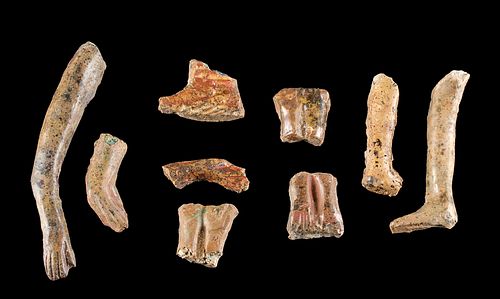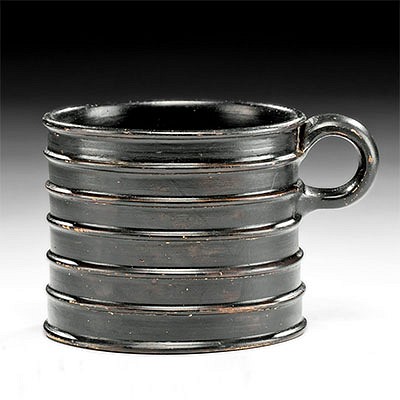9 Egyptian Glass Fragments - Lion & Human Appendages
Lot 13
About Seller
Artemis Gallery
686 S Taylor Ave, Ste 106
Louisville, CO 80027
United States
Selling antiquities, ancient and ethnographic art online since 1993, Artemis Gallery specializes in Classical Antiquities (Egyptian, Greek, Roman, Near Eastern), Asian, Pre-Columbian, African / Tribal / Oceanographic art. Our extensive inventory includes pottery, stone, metal, wood, glass and textil...Read more
Categories
Estimate:
$2,500 - $3,500
Absentee vs Live bid
Two ways to bid:
- Leave a max absentee bid and the platform will bid on your behalf up to your maximum bid during the live auction.
- Bid live during the auction and your bids will be submitted real-time to the auctioneer.
Bid Increments
| Price | Bid Increment |
|---|---|
| $0 | $25 |
| $300 | $50 |
| $1,000 | $100 |
| $2,000 | $250 |
| $5,000 | $500 |
| $10,000 | $1,000 |
| $20,000 | $2,500 |
| $50,000 | $5,000 |
| $100,000 | $10,000 |
| $200,000 | $20,000 |
About Auction
By Artemis Gallery
Mar 12, 2020
Set Reminder
2020-03-12 10:00:00
2020-03-12 10:00:00
America/New_York
Bidsquare
Bidsquare : Ancient / Ethnographic Around The World
https://www.bidsquare.com/auctions/artemis-gallery/ancient-ethnographic-around-the-world-4957
Ancient art from Egypt, Greece, Italy and the Near East, as well as Asian, Fossils, Pre-Columbian, Native American, African / Tribal / Oceanic, Spanish Colonial, Russian Icons, Fine art, much more! Artemis Gallery info@artemisgallery.com
Ancient art from Egypt, Greece, Italy and the Near East, as well as Asian, Fossils, Pre-Columbian, Native American, African / Tribal / Oceanic, Spanish Colonial, Russian Icons, Fine art, much more! Artemis Gallery info@artemisgallery.com
- Lot Description
Egypt, Ptolemaic to early Romano-Egyptian period, ca. 332 BCE to first half of 1st century CE. A fine gathering of nine fragmentary, mold-cast, opaque glass inlays meant to decorate recessed areas of wooden coffins or limestone reliefs. Two curved fragments resemble the bushy tip of a lion tail, and three fragments depict pairs of parallel feline feet. One red-hued fragment shows a pair of human feet with the bottom of a dress at the ankles. Two human leg fragments extend from the knee to the foot sole, and the largest fragment exhibits the form of a lengthy human arm with incised fingers. Size of largest (arm): 3.2" L x 0.25" W (8.1 cm x 0.6 cm)
For a wonderful example of glass inlays inserted into a wooden coffin, please see: Stern, E. Marianne and Birgit Schlick-Nolte. "Early Glass of the Ancient World: 1600 B.C. - A.D. 50 | Ernesto Wolf Collection." Verlag Gerd Hatje, Germany, 1994, p. 60, fig. 90.
Provenance: ex-Dr. Sid Port collection, California, USA, acquired in the 1970s; ex-Norman Blankman collection, New York, USA, acquired in the 1950s in Cairo, Egypt
All items legal to buy/sell under U.S. Statute covering cultural patrimony Code 2600, CHAPTER 14, and are guaranteed to be as described or your money back.
A Certificate of Authenticity will accompany all winning bids.
We ship worldwide and handle all shipping in-house for your convenience.
#153323All items are fragments of larger glass compositions and have been professionally cleaned and conserved. Repairs to human feet, both legs, and largest arm, with light resurfacing and adhesive residue along break lines. All items have minor nicks and abrasions to faces and peripheries, with softening to some finer details and fading to original coloration. Light earthen deposits throughout, and nice rainbow iridescence on some fragments.Condition
- Shipping Info
-
All shipping is handled in-house for your convenience. Your invoice from Artemis Gallery will include shipping calculation instructions. If in doubt, please inquire BEFORE bidding for estimated shipping costs for individual items.
-
- Buyer's Premium



 EUR
EUR CAD
CAD AUD
AUD GBP
GBP MXN
MXN HKD
HKD CNY
CNY MYR
MYR SEK
SEK SGD
SGD CHF
CHF THB
THB














